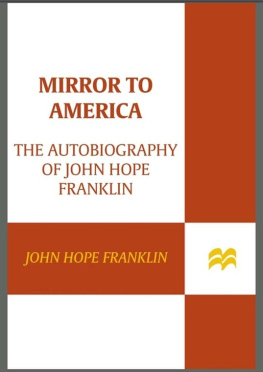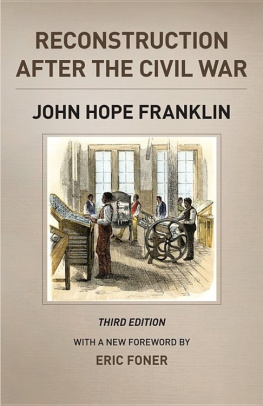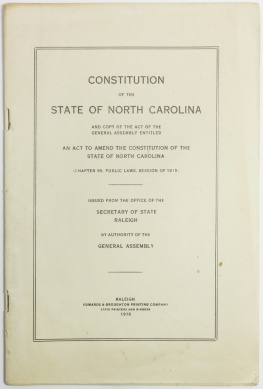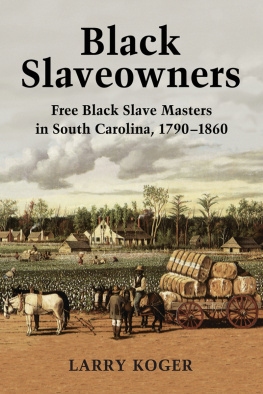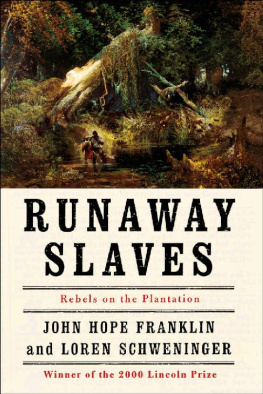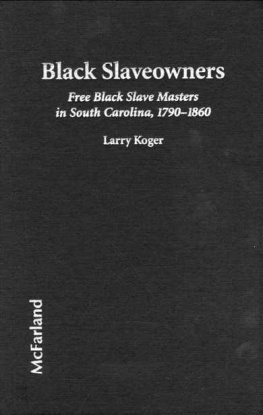The Free Negro in North Carolina
1943 by The University of North Carolina Press
1971, 1995 by John Hope Franklin
All rights reserved
Manufactured in the United States of America
Library of Congress Cataloging-in-Publication Data
Franklin, John Hope, 1915
The free Negro in North Carolina 17901860 / by John Hope Franklin ;
with a new foreword and bibliographic afterword by the author.
p. cm.
Includes bibliographical references and index.
ISBN 0-8078-4546-9 (pbk. : alk. paper)
1. Free Afro-AmericansNorth CarolinaHistory18th century. 2. Free Afro-AmericansNorth CarolinaHistory19th century. 3. North CarolinaHistory17751865 I. Title.
E185.93.N6F7 1995
975.600496073dc20 95-35724
CIP
The paper in this book meets the guidelines for permanence and durability of the Committee on Production Guidelines for Book Longevity of the Council on Library Resources.
The original publication of this volume was aided by a grant from the American Council of Learned Societies from a fund provided by the Carnegie Corporation of New York, and by a grant from the Alpha Phi Alpha Fraternity.
03 02 01 00 99 7 6 5 4 3
TO MY FATHER AND IN MEMORY OF MY MOTHER
Contents
Illustrations
MAPS
I The Free Negro Population in 1800
II The Free Negro Population in 1830
III The Free Negro Population in 1860
IV The Vote to Disfranchise Free Negroes in the Convention of 1835
V The Vote to Equalize Representation in the House of Commons, in the Convention of 1835
VI North Carolina in 1860
TABLES
I White Population in North Carolina in 1790
II Population of North Carolina, 17901860
III Free Negroes in Leading North Carolina Towns in 1860
IV Free Negro Apprentices in Craven County, 18001860
V Occupations of Free Negroes in North Carolina in 1860 135
VI Contributions of Citizens of North Carolina to the American Colonization Society
VII Emigrants to Liberia, 18511860
Foreword
After 1943, when The Free Negro in North Carolina first appeared, writings on free blacks increased enormously. The context for studying free blacks was strange, indeed, in a society whose constitution offered protection to slaves but not to free blacks and whose state laws proscribed them in a dozen different ways. Even so, the study of free blacks gradually became a respectable field of intellectual inquiry, and scholars rushed in to make the most of a relatively virgin field. Studies of free blacks gave attention not only to the South but the North as well. They dealt with urban as well as rural areas. There were studies of the occupational pursuits of free blacks and studies of their social and cultural development. Some were brief articles, while some were lengthy works. They were inevitably uneven in quality, but they covered virtually every aspect of life. They give the subject a place in serious historical study that it was just beginning to have in 1943.
Impetus to this interest in free blacks was doubtless provided in the mid-1920s by Carter G. Woodson, the founder-director of the Association for the Study of Negro Life and History. He published two exceptional monographs on the subject: Free Negro Owners of Slaves in the United States in 1830 (1924) and Free Negro Heads of Families in the United States in 1830 (1925). He also encouraged scholars to submit articles on the subject to the Journal of Negro History, of which he was the editor. Luther P. Jackson, whose work on free blacks in Virginia was already under way, published some of his early findings in Woodsons Journal. Likewise, Princetons Roger W. Shugg won the Journals Bancroft Prize for his pathbreaking Negro Voting in the Ante-bellum South. Thus, although so much about free blacks was still unknown in the early 1940s, the way had surely been prepared for the large-scale works on North Carolina and Virginia that appeared in 1943 and 1944, respectively.
By the 1960s the study of African Americans in general and free blacks in particular had become on of the most important, even fashionable, areas of study in U.S. history. As in virtually all aspects of African American history, numerous historians became involved in the study of free blacks; and some of them produced real gems. In 1958 Leon Litwack wrote a doctoral dissertation that three years later became North of Slavery: The Negro in the Free States, 17901860. It was the first systematic study of free blacks in the antebellum North and became a painful reminder of the disesteem in which free blacks were held, whether in the North or the South. In 1961, Larry Garas Liberty Line examined the attitudes of Northern free blacks toward the crusading abolitionists.
FREE BLACKS were essentially an urban people. Plantation owners and white farmers did not want them around because they set a poor example for those in thralldom who were not permitted to view freedom as a status to which blacks could aspire or were entitled. Although scholars wrote about urban blacks in the years following the publication of The Free Negro in North Carolina, it was not until 1981 that Leonard P. Curry produced his landmark study, The Free Black in Urban America, 18001850. It became clear in Currys work that the urban community was the natural home for free blacks, one where they were most likely to secure and maintain their freedom. Currys work was a climax to the considerable attention that had been given to free blacks during the previous two decades.
No area of life among free blacks seemed to escape historians working in the field from the 1940s to the late 1960s. It was left to Ira Berlin, however, to provide the synthesis that would be the model for all students in the field. His Slaves Without Masters: The Free Negro in the Antebellum South (1974) provided salient and significant generalizations that were both thoughtful and instructive. He reminded his readers that his work was essentially a study of the slave South, observing that just as the study of any anomalous group, whether they be children, the insane, criminals, or even intellectuals, is a telling indicator of the larger society, so the status of the free Negro is a sensitive measure of Southern attitudes on race and class.
While few studies of free blacks measure up to the majesty of the works by Litwack, Berlin, and Curry, all of them are important in providing new light on an old, important subject. And while Berlins claim that the study of the free black is a study of the slave South can hardly be disputed, it is more than that. Free blacks were a group unto themselves. They worked, played, struggled to improve their legal and economic status, and engaged in religious worship in a variety of ways. Many of them emerged from the dim shadows of their anomalous position to become not merely distinct persons but even heroic figures. One cannot learn of William Johnson of Natchez, Marie Metoyer of New Orleans, and John Chavis of Raleigh without realizing that they were, in many ways, larger than life. If they were exceptionaland indeed they weretheir high standing in the larger community underscores the danger of making generalizations about even the most precariously placed group in the social order.
John Hope Franklin
July 1995
Preface
In Studying the free Negro in North Carolina before the Civil War, perhaps nothing is more striking than the similarity between the attitude of the ante-bellum community and the attitude of various communities today, including the United States, toward certain smaller groups within their midst. These attitudes, in both cases, interestingly enough, sprang not so much from the belief that the smaller group was inherently incapable of accommodating itself to its environment as from a profound conviction that it was socially and economically undesirable. In the wake of this conviction there followed a train of manifestations and rationalizationsunconscious, subconscious, and consciouswhich reflected this undesirability. The larger community, thereupon, was determined to make adjustment for the smaller group impossible. These reactions, in the period before the Civil War, did much to make the free Negro a problem and to create the complexities that make his status so difficult to ascertain and to understand.
Next page

